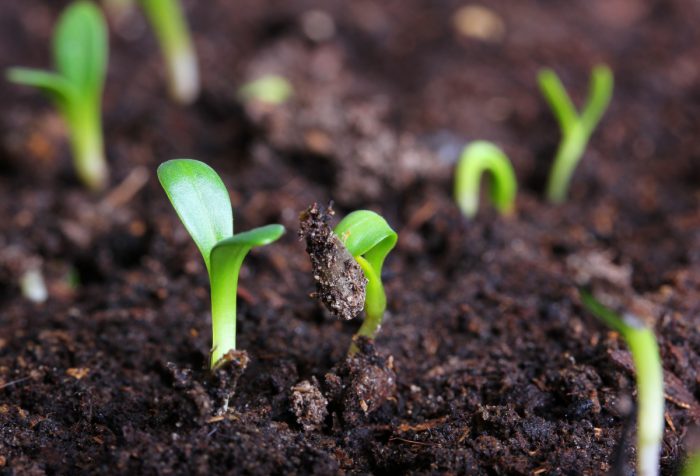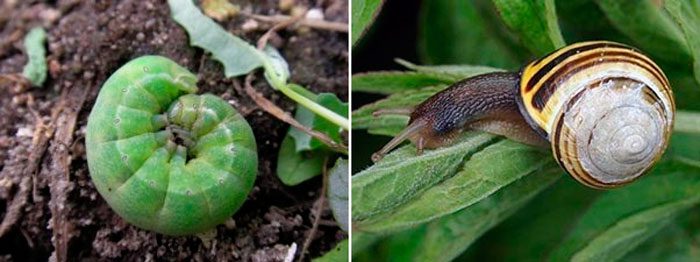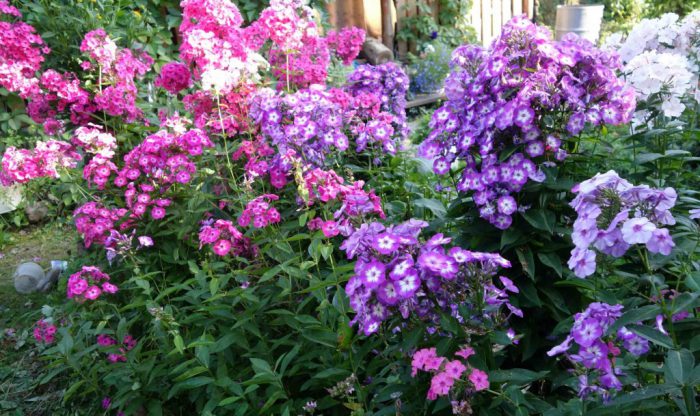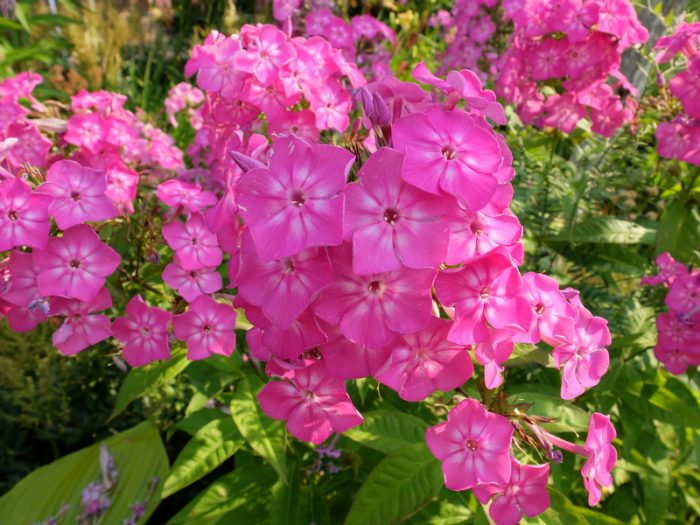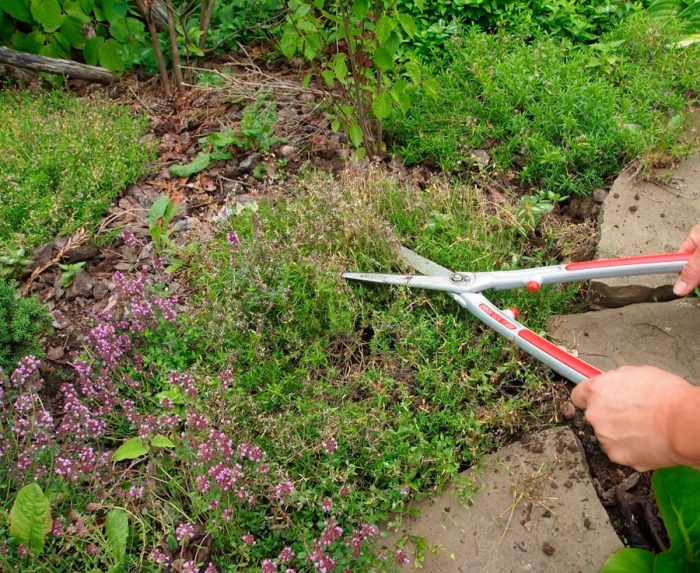Such a herb as phlox (Phlox) is directly related to the cyanide family (Polemoniaceae). This genus unites about 70 species, while about 40 species are cultivated. Phlox was first grown in European countries in the middle of the 18th century. To date, thanks to breeders, about 1.5 thousand different varieties of such flowers have appeared. From the Greek language "phlox" is translated as "flame". So this plant was named by K. Linnaeus in 1737, and that's all, because in some of the phlox species, the flowers have a very rich color. In natural conditions, such flowers can be found in North America. Due to the fact that the climate of those places is rather harsh, the plant is distinguished by its undemanding care and vitality. And the flowers of phlox are incredibly fragrant, and the flowering itself is long.
Content
Features of phlox
Phloxes, even of the same species, can differ greatly from each other, and this is influenced by the peculiarities of the climate in which the flower grows. So, for example, those plants that grow at an altitude of 4 thousand meters are bryophyte and have a rather low growth, only 5-25 centimeters. Their branching stems cover evergreen leaf blades. If the plant grows in favorable climatic conditions, then it has an erect bush that can reach a height of 30-180 centimeters. There are also semi-shrubs. These plants also differ in flowering time. So, there are early (spring), middle (summer), as well as late (summer-autumn). Most often there are erect varieties and species. Sessile, entire, oppositely located leaves can be elongated-ovoid or lanceolate-oval in shape. The flower diameter ranges from 2.5 to 4 centimeters. They have a tubular-funnel shape and are part of a complex inflorescence. So, in one inflorescence there can be up to 90 flowers. The flower consists of 5 stamens, 5 slightly bent petals, and 1 pistil. Most phlox species are perennials. However, Drummond's phlox (Phlox drummondii) and its various forms and varieties are considered annuals.
Main types and varieties
Annual phlox


The best annual phlox grown in the garden is Drummond... The Englishman G. Drummond, who was a naturalist, traveler and theologian, brought him to England from Texas in 1835. In England, this flower has taken root. Flowering of such a plant begins in June and ends with the onset of the first frost. Opposite leaves have a lanceolate-oval shape. The thin stem is quite branchy, and it reaches a height of 20-30 centimeters. The color of fragrant flowers is dark red, yellow, purple, white and salmon.
Plants of this species are divided into 2 varieties, namely: large-flowered and star-shaped. High phlox Drummond star-shaped (Phlox drummondii cuspidata), as a rule, reaches 30-40 centimeters, but there are also more compact plants (up to 12 centimeters). The split petals give the bright flower a star-like appearance with a peephole in the center. Phlox Drummond grandiflorum (Phlox drummondii mixed) - as a rule, its height does not exceed 30 centimeters. Its flowers are quite large and can be colored in various shades of color. But plants with flowers of red shades are more impressive.
Florists also divide these plants in size into dwarf ones, which reach a height of 15 to 20 centimeters, as well as large-flowered ones. The large-flowered cultivars are High Fire Red, High White and High Bright Red. Varieties related to dwarf phlox: Chamoa (pink), Salmona (salmon), Snow Globe (white), Isabella (yellow) and Defiance (fiery red). All varieties of this type of phlox have both semi-double and double varieties. The most popular are terry flowers of the Promis variety of various colors.
Phlox perennial
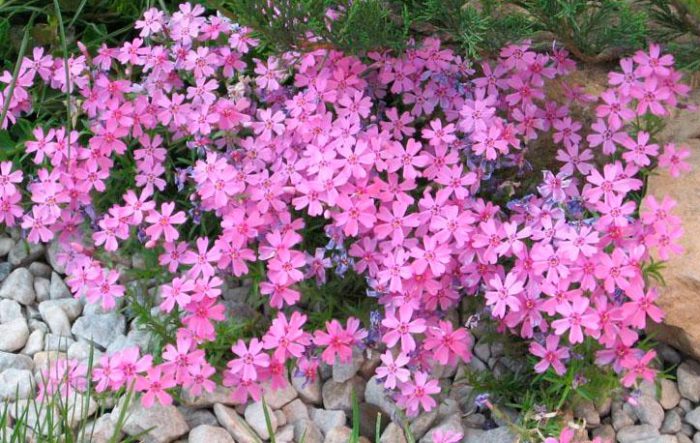

The earliest perennial phlox species is subulate, its bloom begins in May. The plant itself is highly branching and blooming profusely. During flowering, the bush is completely covered with flowers, which can be of various shades from dark red to pure white. The leaves are narrow, awl-shaped, which influenced the name of the variety. Such a plant is suitable for decorating alpine slides, as well as rockeries.
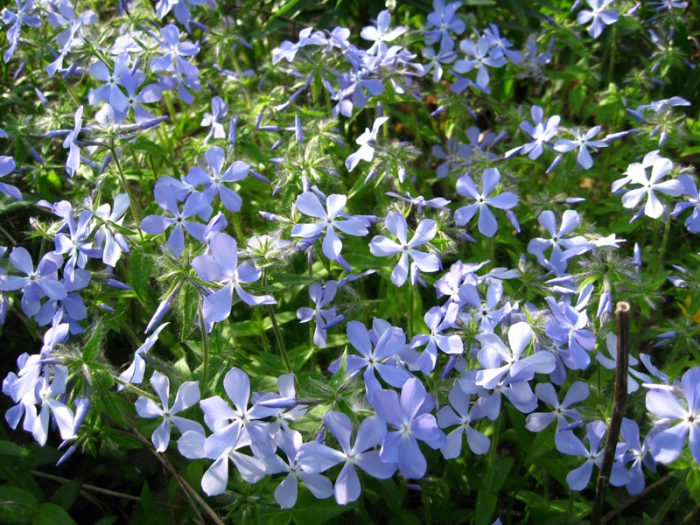

Phlox bloom spread out also begins in May, but 7–14 days later than subulate phlox. Compact bushes are decorated with small bluish-lilac flowers. This species loves light less than the previous one, and also has less dense, but larger foliage and ligneous shoots.
The flowering of phlox paniculata occurs in the middle of the summer period. This type is very popular among gardeners. It has spectacular green leaves and fairly large inflorescences, consisting of many beautiful fragrant flowers.
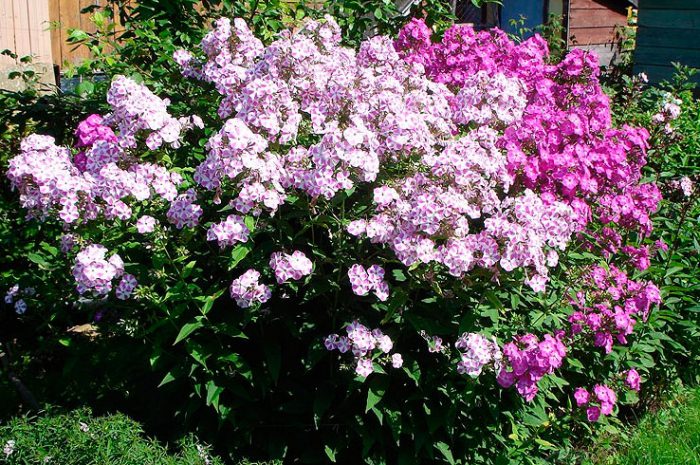

Phlox paniculata - thanks to this species, a large number of very interesting varieties were born. So, among them, the terry phlox Pure Feelings stands out, in which rather large inflorescences consist of white flowers, a strip of green color runs in the center, and purple flowers are located in the lower part. Elongated petals are slightly twisted. The bush can reach a height of 70 to 80 centimeters. Natural Feelings terry phlox deserves special attention. Inflorescences similar to flowering branches of lilacs consist of small greenish-white-pink flowers. Also, thanks to breeders, frost-resistant varieties appeared, for example, Phlox Orange (Orange Perfection, Orange Spat), the flowers of which are painted in various shades of red-orange, which do not fade under the influence of sunlight. They are undemanding, reproduce easily and have a spectacular appearance. The most popular of the varieties is the Phlox King.The bush can reach 100 centimeters in height, the flowers of such a plant are quite large (about 4 centimeters in diameter) and can be colored pink, white, crimson, lilac, as well as other color shades.
Growing phlox from seeds
When grown properly, blooming phloxes can beautify your garden from spring until the fall. The most popular way of propagation of such plants is vegetative (by layering, cuttings and dividing the bush). However, some gardeners prefer seed reproduction of phlox. Perennial seeds freshly harvested in autumn must be sown in the soil in winter (in November or December). First you need to decide on the site where these plants will be grown for several years. In the event that snow has already fallen, it should be removed from the garden bed and simply scattered seeds over the surface of the soil, trying to leave a distance of 4-5 centimeters between the seeds. After that, a small (about 1–1.5 centimeters) layer of pre-sieved soil must be poured over them. And then cover everything again with snow. You can purchase soil in a special store or collect it in advance. Freshly sown seeds have a germination rate of approximately 70 percent. But with the onset of spring, it decreases significantly. At the very beginning of spring, phlox shoots will appear on the garden bed. They should be picked only after 2 pairs of true leaves are formed on them. The distance between the plants should be about 20 centimeters. The planting of such seedlings should be carried out in due time.
As a rule, phlox, which are annuals, are propagated by seeds. To do this, in the spring time should be sown seeds, leaving a distance of about 3-4 centimeters between them. Then you should water from a sprayer and cover the bed with plastic wrap. You should not pour soil over the seeds, but you need to raise the shelter for a while every day and remove the formed condensate. After the first shoots appear, the shelter should be removed.


Watch this video on YouTube
Planting and caring for annual phlox
How to plant annual phlox
The cultivation of such plants from seeds is discussed above. However, there are gardeners who are afraid of night frosts in spring, which can destroy the plant, so they prefer to grow seedlings at home. Seeds are sown at the beginning of the spring period (in March). The first shoots can be seen only 7 days after sowing. Young plants need to be provided with a sufficient amount of light, watering, and also a moderate temperature regime. After 14–21 days after the emergence of seedlings, the plants must be dived. After the pick is made, it is recommended to shade phloxes from direct sunlight for several days. They can be covered with newspaper sheets or opaque film. While the seedlings are growing in the house, you can apply mineral fertilizers 2 or 3 times to the soil, while using ½ part of the dose recommended for adult phlox. To make the bush more lush, after 4 or 5 real leaves appear on it, they pinch.
Seedlings are planted in May, while a distance of 15 to 20 centimeters is left between the bushes. To successfully grow phlox, you need to find a suitable place. Annual phloxes are not afraid of cold and drought, they love light, but they react negatively to overheating of the roots. The most spectacular plants grow in partial shade. It is noticed that the more the area is shaded, the longer this plant will bloom, but at the same time fewer flowers will grow on it. It should be noted that most varieties fade in the sun during the flowering period. But this does not threaten plants in partial shade.The color of their flowers remains saturated for a long time. Particularly beautiful are the "blue" varieties growing in a shaded place, the flowers of which, in poor light, become almost blue. For planting phlox, it is recommended to use high beds, next to which there are no shrubs or trees with a fairly branched root system.
Such a plant needs soil, which contains a lot of humus. It should be noted that the plant may die in heavy soil with poor drainage. If you have chosen an area with acidified soil for planting, then lime must be added to it. The most suitable for growing such flowers is fertile sand, which does not contain clay. If the plants planted in it are well watered, they will grow powerful and beautiful. Before planting phloxes in heavy loam, organic fertilizers, sand, and peat must be added to it. Prepare a not very deep hole for the plant and be sure to add compost, vermicompost or 2 handfuls of wood ash into it. The roots should be spread horizontally.
Caring for annual phlox
Growing phlox annuals will not be difficult. So, they need to carefully loosen the top layer of the soil 6–8 times per season, in the second half of the period of intensive growth it is necessary to spud the plant while loosening, for better and faster formation of the root system. Organic and mineral fertilizers should also be applied to the soil. In the last days of May, it is necessary to feed the phlox with liquid manure for the first time (25 g of the substance is taken for 10 liters of water). The second top dressing is carried out in the first days of June, but at the same time superphosphate or potassium salt must be added to the finished liquid manure. In the first days of July, liquid manure (without additives) should be applied to the soil for the third time. In the last days of July, the plant should be fed 4 times, while the fertilizer should contain potassium salt and phosphorus.
How to water properly
Plants should be provided with systematic moderate watering in the morning or evening. When watering, water should be poured at the root, while 15–20 liters of water should be consumed per 1 square meter. Watering phlox with cold water on a hot day can lead to cracking of their shoots. It is recommended to pick off wilted flowers, because they are a hindrance to those that have not yet blossomed.
Diseases
Phloxes can get variegated. In this case, a pattern unusual for this plant appears on the surface of the leaves and flowers, which significantly impairs the decorative qualities of the flower. It is impossible to cure a diseased plant, so it must be dug up and destroyed. If phloxes become infected with powdery mildew, then they will also need to be destroyed. You can understand that the flower is sick by the matte white bloom that has appeared on the foliage and shoots.
Such a plant can also get sick with formosis, in this case the leaves dry out, and the stems become fragile. For preventive purposes, it is necessary to process foliage and shoots with colloidal sulfur. It should be borne in mind that during processing the air temperature should be above 18 degrees, and the substance should not be allowed to get on the inflorescences. When infected with septoria, dots of dark brown color are formed on the surface of the foliage. With the development of the disease, their size increases. A diseased plant must be treated with Bordeaux liquid, as well as the surface of the soil near it. After half a month, re-processing is carried out. Verticillium wilt has a detrimental effect on the root system of the plant, but only those phloxes that grow on acidic soil are susceptible to such a disease.


Watch this video on YouTube
Pests
A nematode (a very small filamentous worm) can settle on the plant, which sucks out the juice from it.A sign that phlox has such a pest is disfigured inflorescences, crushed flowers and thinned shoots. The infected plant is dug up and destroyed (burned). The soil must be treated 3 times with nematicides, while the interval between treatments should be maintained at 3 weeks.
Naked slugs can eat leaves, flowers and even the lower part of the shoots at night. Systematic loosening and weeding is an excellent prevention against slugs. In case of severe infection, it is recommended to sprinkle the surface of the soil with wood ash, fluff lime or tobacco dust mixed with ash. Butterfly caterpillars on foliage can be removed manually. In case of severe infection, plants are treated from leaf-eating pests.
Planting and caring for annual phlox
Planting perennial phlox
The planting of such phlox is very similar to that used for annuals. However, when planting plants in the spring, it will be necessary to pour a layer of mulch (humus or dry peat) on the soil surface. The distance between the bushes should be left quite large (about 50 centimeters), since they will grow quite strongly in a few years. When purchasing seedlings of such flowers in autumn, they should not be planted in open ground. It is recommended to dig the seedlings to a depth of 20 to 25 centimeters, choosing for this a site protected from gusts of wind, and snow should also linger on it in winter. After the soil freezes, cover the plants with dry foliage or peat.
Sometimes it is allowed to plant perennial phloxes in open ground in the fall. A bush that has grown and has lost its beauty can be divided in autumn (from mid-August to mid-September). For disembarkation, use the lateral dividers, and discard the central part. In the autumn, phloxes are also transplanted to a permanent place, which were planted in spring with cuttings.
During the autumn planting, compost should be added to the soil, and peat is added to the sandy soil, and sand to the clayey soil. The wells are located at a distance of 50 centimeters from each other. Delenki are lowered into them and the roots are straightened horizontally, it is necessary to dig in shallowly (about 4–5 centimeters). In dry weather, watering is carried out in 2-3 days (within 14 days). 2 liters of water is taken per bush. The dried surface of the soil must be loosened and sprinkled with a four-centimeter layer of mulch (humus or peat).
Care
Care rules are similar to those used for annuals. But such plants need to be fed 5 times per season, while the last time fertilizer is applied to the soil during seed formation. For feeding, a solution is used, consisting of 5 liters of water, 10 g of superphosphate and 5 g of potassium sulfate. You need to feed in the evening after watering, while do not let the solution get on the foliage. If you take care of the plants correctly, they can be grown in the same area for 7 years.
Cuttings of these plants can be carried out during the entire period of intensive growth. The beginning of grafting falls on the time when the stem reaches a height of 5 centimeters, and the end - on the last days of September. Cuttings taken from the plant in spring and summer are best rooted. You can propagate the plant by layering. Before the plant fades, its shoot is bent to the surface of the soil, fixation is made along the entire length and spud with a mixture of peat and humus. In autumn, a young plant is separated from the mother bush and planted in a permanent place.
Features of care after flowering and in winter
Annuals can grow in the spring of next year, but their decorative qualities will be low. After collecting the ripe seeds in autumn, remove the remnants of the plants, and dig up the soil, while removing the remaining rhizomes.
In the snowless winter period, the growth buds of phlox are likely to freeze out in frosts of about minus 10-15 degrees.If it is colder than 20-25 degrees, this will lead to the death of the root system. In this regard, in the autumn, the dried upper part of the plant must be removed, and the root collars must be covered with a layer of soil mixed with peat. From above, cover them with dried foliage, straw or spruce branches. With a snow cover of 50-60 centimeters, phloxes calmly withstand thirty-degree frosts.


Watch this video on YouTube




